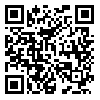BibTeX | RIS | EndNote | Medlars | ProCite | Reference Manager | RefWorks
Send citation to:
URL: http://irje.tums.ac.ir/article-1-5442-en.html
2- Research center for Modeling in Health, Institue for future studies in Health, Department of Biostatistics and Epidemiology, Faculty of Health, kerman University of Medical Sciences, kerman, Iran ,
Background and Objectives: Diabetes is a chronic and common metabolic disease which has no curative treatment. Logistic regression (LR) is a statistical model for the analysis and prediction in multivariate statistical techniques. Discriminant analysis is a method for separating observations in terms of dependent variable levels which can allocate any new observation after making discriminating functions. The aim of this study was to compare and determine the effective variables in type 2 diabetes.
Methods: The data included 5357 persons obtained through a cohort study in Kerman, southeastern Iran, in 2009-11. Diabetes was considered the response variable. The independent variables after deleting colinearity and correlated variables included height, waist circumference, age, gender, occupation, education, drugs, systolic blood pressure, HDL, LDL, drug abuse, activities, and triglyceride. Sensitivity, specificity, accuracy, and ROC curve were applied for determining and comparing the prediction power of the models.
Results: The results in the reduced model with extracted significant variables from the full model, the sensitivity of the LR model and DA was 74% and 22.4%, the specificity of the LR model and DA was 71.1 % and 95.4 %, the prediction accuracy of the LR model and DA was 71.5% and 85.3%, and the ROC curve of the LR model and DA was 80.3% and 80.1%, respectively.Simulation showed the sensitivity, specificity, accuracy, and ROC curve was 99.18%, 98.49%, 98.59%, and 99.9% for the LR model and 92.62%, 99.19%, 98.26%, and 99.56% for DA, respectively.
Conclusion: The results showed that the risk factors of diabetes in the logistic regression reduced model were waist circumference, age, gender, LDL level, systolic pressure, and drugs. Also, the sensitivity of the LR model was more than DA while DA had a higher specificity and prediction accuracy. Comparison of the ROC curve showed that the prediction estimated values were rather similar in both models, but the two models were the same asymptotically.
Received: 2016/02/28 | Accepted: 2016/02/28 | Published: 2016/02/28
| Rights and permissions | |
 |
This work is licensed under a Creative Commons Attribution-NonCommercial 4.0 International License. |





